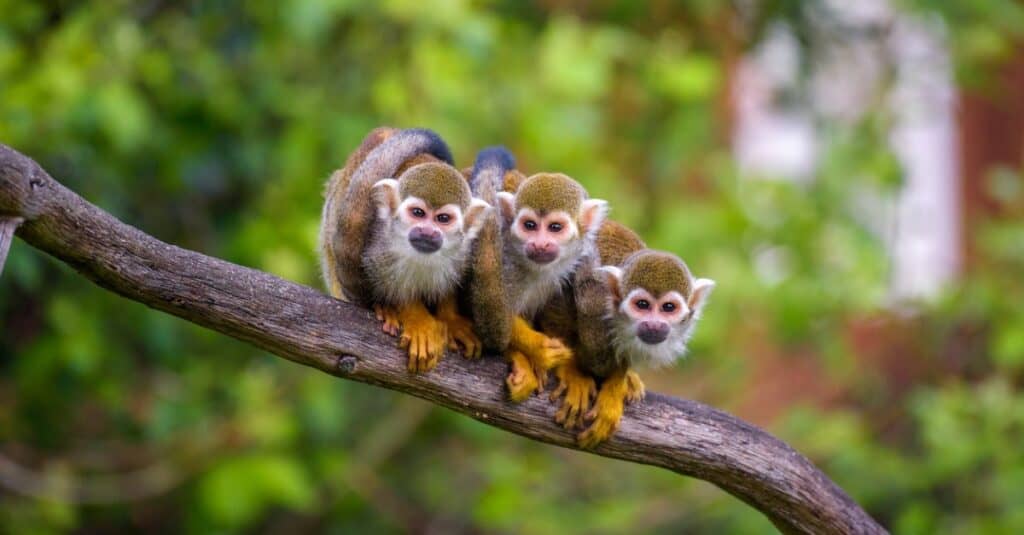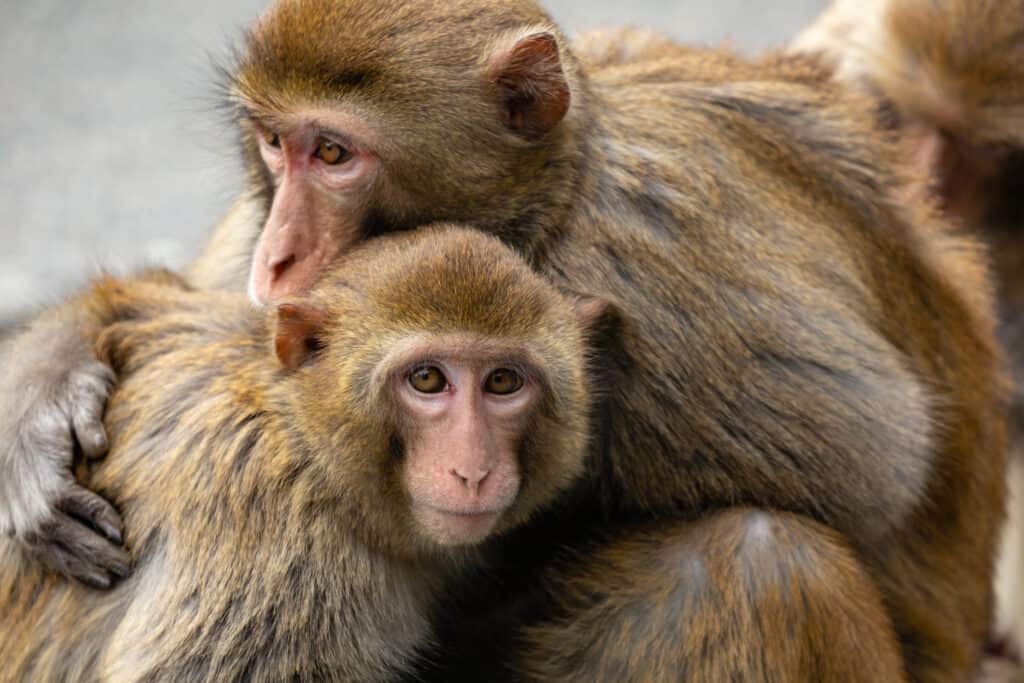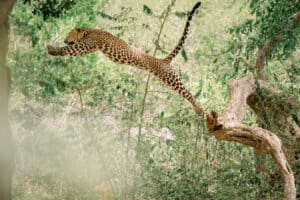Fifty-six million years ago, some North American monkeys occupied this continent. Since then, these clever animals have evolved and now inhabit warmer, humid regions like tropical jungles. However, other primates like the Japanese macaque live in ice-cold, snowy conditions. So, why don’t North American monkeys exist natively any longer and only occupy regions south of Mexico?

Monkeys are no longer native to North America because they adapted millions of years ago to tropical and semi-tropical climates.
©iStock.com/miroslav_1
Why Did Monkeys Live in North America?
When the northern parts of North America were much warmer than today, it was common to find monkeys living as far north as Canada. However, for a long time, experts thought they had become extinct in North America because of the influx of rodents. Because animal experts thought that monkeys competed with rodents for food, the decline of rodents led them to believe that monkeys had become extinct in the north. However, paleontologists from the Johns Hopkins University School of Medicine recently showed that this assumption was wrong and that monkeys and rodents did not eat the same foods.
Why Did They Die Out in North America?
Today, monkeys live in warmer climates and prefer forests. But unfortunately, when the earth’s temperature dropped around 39 million years ago, the forest linking North and South America also died out. This loss caused the North American monkeys to die out since they couldn’t adapt to the cold.
The Drake Passage lies between South America and Antarctica. Scientists believe that this passage used to be a barrier between the Pacific and South Atlantic, which is cooler. This passage caused cooler weather across the northern hemisphere and led to the extinction of monkeys in North America.
Also, fossil finds show only one platyrrhine monkey in the Caribbean. This little monkey adjusted to living on the ground instead of in the trees. However, a lack of trees and heat stopped it from crossing into North America.
Monkeys Need a Unique Climate
North America does not offer monkeys the living conditions they have grown to prefer. North America is much colder than South America, and there is a distinct lack of tropical forests. Monkeys also prefer tropical climates, which means they need warm, humid conditions. Unfortunately, this environment isn’t present in North America. Monkeys also prefer high levels of rain. This preference is also why they do not inhabit North America. The rainfall isn’t high enough.
The early North American monkeys looked a lot like tarsiers. They had large eyes and hands with claws. They survived mainly on insects and fruits and lived mostly in treetops.
As the planet cooled down, their habitats died out. These monkeys struggled to adapt, causing them to go extinct. This event was a mass extinction that hit primates and other species hard.
The remaining monkeys on the South American continent became known as New World monkeys. New World monkeys aren’t adaptable to different climates like their cousins from Africa. New World monkeys struggle to adapt to colder weather and often become ill if they do not stay warm.
Why Are There No Snow Monkeys in North America?
We know that there are certainly monkeys that adapted to living in cold climates, like the Japanese macaques. But why did the North American monkey species not adjust to cold conditions since it is clear they adapt to temperate conditions?
Recall, though, that primates didn’t originate in North America. Instead, experts believe that easterly winds pushed African vegetation across the Atlantic Ocean. This vegetation formed rafts, which could have undoubtedly carried monkeys to the Americas.
The most likely candidates to end up on vegetation rafts would have been tree-dwelling monkeys. But for monkeys to reach forested habitats, they would have had to cross sparsely wooded areas. This process must have been perilous for them.

Japanese macaques are adaptable, living in the icy mountainous regions of Japan.
©Yosemite / Creative Commons – Original
Scientific research confirms that the continents were all closer together at one time than today. So, for example, proximity between South America and Africa would have made animal migration simpler. And to support this theory, South American and African monkeys descended from a common ancestor. In addition, Africa and South America have other links. One of these is that lemurs, also referred to as bush babies, and many other tropical plant and animal species originate in South America and are found on both these continents.
Foreign Monkeys Thrive in North America
Silver Spring State Park lies in Central Florida. The park has been popular for its monkey population for over 80 years. However, the rhesus macaques that populate the park were originally escapees from a planned theme park. This rhesus macaque group grew between 1984 and 2012. In 2012, Florida wildlife officials authorized the removal of more than 1,000 individuals. Since then, their numbers have risen again, attracting many tourists. And tourists love nothing better than to feed these monkeys, a habit that can quickly lead to conflict between monkeys and humans. In addition, because monkeys aren’t native to Florida, they seem to adapt quickly and are a nuisance to humans. But removing them also isn’t the best solution. These scenarios leave officials with various competing options, but which will provide the answer to an overgrowth of these North American monkeys that are not native to the region?
Free Roaming or Protected Areas?
There are competing options here, and they make sense. On the one hand, park officials want to cater to tourist interests. Visitors enjoy seeing the monkeys in a natural environment and pictures and videos on the internet. But on the other hand, the Florida Fish and Wildlife Commission intends to establish protected areas where the monkeys wouldn’t be allowed to wander freely. Although the options conflict, both seem reasonable enough, so it is hard to determine which choice provides the best solution to contain the flourishing of these invasive monkey populations.
Female Monkey Sterilization or Trapping?
Sterilization of female monkeys destroys their ability to reproduce by blocking or eliminating the appropriate reproductive organs and is a viable option. Trapping and removal were also an option. But this caused an uproar from the public when they discovered that researchers had bought the monkeys. Both these options are costly in terms of labor, money, and time.

Rhesus macaques appear to be one of the most adaptable, having become an invasive North American monkey species.
©iStock.com/Zane Michael Cooper
Ongoing Threat of Invasive North American Monkeys
Rhesus macaques aren’t as afraid of humans as other monkeys, which poses risks to families and individuals. Macaques often stray beyond park limits and wander as far away as 100 miles. They have a varied diet, which can easily lead to overfeeding and extinction of native species. In addition, the introduced non-native species can harm indigenous animals and plant life. Harm occurs because the introduced species can consume plant life in excess, which is a limited resource for local animal populations. The question remains on what to do about non-native North American monkeys that continue to threaten local environments.
Related Animals
Enjoy reading about these related monkey articles:
- Do Monkeys Really Eat Bananas?
- Can Monkeys Swim?
- Monkey Feet: Everything You Want to Know
- 6 Types of Monkeys in Florida
The photo featured at the top of this post is © Eric Gevaert/Shutterstock.com
Thank you for reading! Have some feedback for us? Contact the AZ Animals editorial team.







